![]()
Home | Introduction | Magnetic Fields | Magnetic Force | Stored Energy in Magnetic Fields | Magnetism on the Sun | Further Exploration | Bibliography
![]()
Magnetic reconnection
One important aspect of magnetism on the Sun is magnetic reconnection , which can be better understood if we first examine what plasma is: Plasma is a state of matter occurring at high temperatures where electrons are not bound to the nucleus. As a result, ions and electrons are free to move about the material. The free movement of charges makes plasma highly conductive, thereby causing magnetic field lines to be "frozen" into the plasma.SunspotsIn reconnection, fluid motions in plasma bring together two "frozen" and oppositely directed magnetic field lines. These field lines then reconnect into a lower energy state. As we found out in the Magnet Acrobatics activity, magnetic fields can store energy. Energy is stored in reconnection when the "frozen" field lines become distorted as a result of fluid motion. Reconnection reduces the amount of distortion, which in turn causes energy to be released. This can be illustrated in the following activity with rubber bands.
Reconnecting Rubber Bands - Since magnetic reconnection occurs in plasmas, which cannot be feasibly produced in a high school lab, we will have to be content with an activity using rubber bands to model magnetic reconnection. This activity requires two people.
Equipment:Magnetic reconnection is important to solar physicists since they think that it in part is the cause of flares and coronal mass ejections (CMEs). It is also thought to be a possible heat source for the corona, which is unexpectedly hotter than the surface layers below it.A flat rubber bandProcedure:
Two binder clips
A marker
A pair of scissors
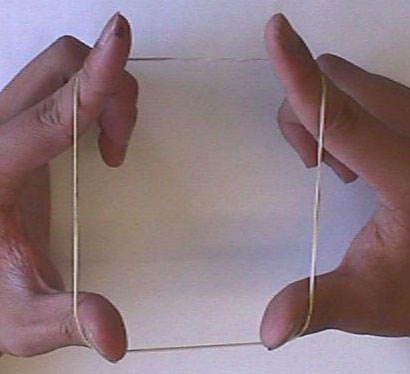
Have your partner stretch out the rubber band into a rectangle using the index finger and thumb of both hands as corners.
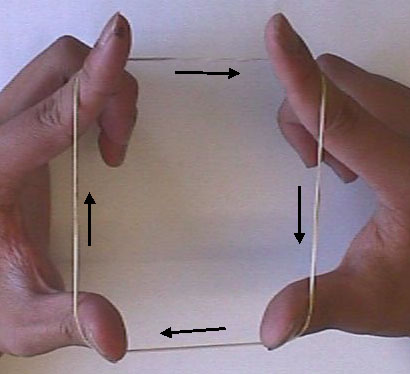
Use a marker to draw four arrows on each side of the rubber band rectangle. The arrows should point in the direction of a closed path traced along the rubber band. The rubber band now represents magnetic field lines.- Choose two opposing sides of the rectangle and pinch them together. This is simulating the distortion of magnetic fields that occurs before reconnection.
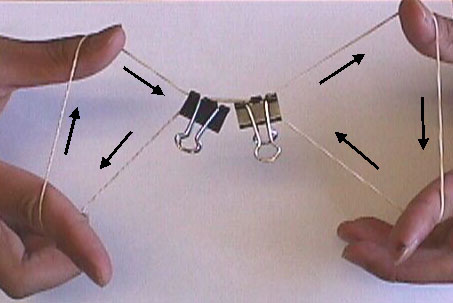
Hold the two opposing sides together with both binder clips.
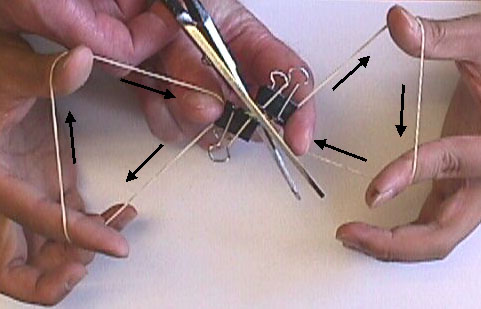
Take a pair of scissors and cut the two "magnetic field lines" between the binder clips. This is simulating reconnection of the field lines.
Note that energy from the rubber bands is released, which also happens during magnetic reconnection.
Features accompanying sunspots (Papagiannis 112) Faculae (or photospheric faculae) are bright areas above the photosphere that appear near sunspots. Although they occur everywhere on the Sun, faculae can only be seen on the limb, or edge of the Sun. This is a result of limb darkening and the different temperatures of the faculae. Limb darkening occurs because only the shallow layers of the Sun that are cooler and less bright can be seen at the limb. Consequently, the limb appears darker than the rest of the Sun. Likewise, only the upper or shallow layers of the faculae can be seen at the limb. Since the upper layers of the faculae are several hundred degrees hotter than the photosphere (whereas its lower layers are cooler) and consequently brighter than the rest of the darkened limb, the faculae are visible.Magnetism is also responsible for the formation of sunspots. Sunspots are small areas on the Sun that appear dark because of their relative low temperature. This low temperature is thought to be caused by magnetic fields. The magnetic field inhibits convection, or the distribution of heat, resulting in a cool sunspot (Tayler 29).
Here's a magnetic vector field animation (19 mb mpeg) showing the magnetic field around a sunspot group on March 29, 2010, observed by the HMI instrument. In this case, the blue color represents "north" polarity (outward), and the red represents "south" polarity (inward).
 Flares
are eruptions of particles and radiation on the surface of the Sun. They
are the result of a buildup in activity around sunspots. Lasting up to
an hour, they release massive amounts of energy equivalent to a billion
megatons of dynamite (Hathaway
par.1). The energy that they release is thought to be from
magnetic reconnnection.
Flares
are eruptions of particles and radiation on the surface of the Sun. They
are the result of a buildup in activity around sunspots. Lasting up to
an hour, they release massive amounts of energy equivalent to a billion
megatons of dynamite (Hathaway
par.1). The energy that they release is thought to be from
magnetic reconnnection.
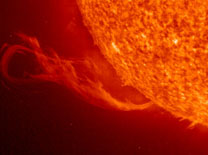 Prominences
are arch-like structures in the corona and are seen at the limb of the
Sun. They are called filaments when they are projected onto the
disk of the Sun. These structures are supported by long lasting magnetic
field formations in quiescent prominences. Active prominences occur over
sunspots, whereas quiescent prominences appear where there are no sunspots
or with decaying sunspot groups.
Coronal mass ejections
Prominences
are arch-like structures in the corona and are seen at the limb of the
Sun. They are called filaments when they are projected onto the
disk of the Sun. These structures are supported by long lasting magnetic
field formations in quiescent prominences. Active prominences occur over
sunspots, whereas quiescent prominences appear where there are no sunspots
or with decaying sunspot groups.
Coronal mass ejections
The flare "myth"One of the most significant consequences of magnetism is the coronal mass ejection (CME), a large scale and sudden expulsion of magnetized plasma from the Sun's corona, or outer atmosphere (Wagner 267). CMEs are so large that they can occupy as much as a quarter of the solar limb. Despite their size, CMEs were not discovered until the 1970s, in part because the Earth's atmosphere prevented instruments from detecting their presence and the erroneous attribution of geomagnetic storms primarily to solar flares. CMEs can send so many charged particles at high speeds to the Earth that they penetrate the magnetosphere, a cavity created by the Earth's own magnetic field that deflects particles from the solar wind. These geomagnetic storms caused by CMEs can disrupt communications & navigation systems, satellites and power grids. Like flares, CMEs derive their energy from magnetic fields. The twisting and distortion of magnetic field lines stores energy in the field which is later released when a CME forms.
Before modern observations proved otherwise, the majority of scientists believed that the geomagnetic storms experienced on Earth were a result of solar flares. As a result, they based their theories on a strong causal relationship between flares and geomagnetic storms. However, starting with the discovery of coronal mass eruptions (which are called coronal mass ejections today) in the spacecraft observations of OSO-7 and Skylab, it is clear that this relationship is wrong. Although solar flares can be very dangerous to the Earth, coronal mass ejections rather than flares are the causes of energy release and geomagnetic storms. Unlike what was also previously thought, flares are not even required for coronal mass ejections to take place.
![]()
 Return
To Activities
Return
To Activities |
 |
 |
 |
 |
 |
 |
 |
||||
 |
 |
 |
 |
Last revised by Eugene on August 25, 1999